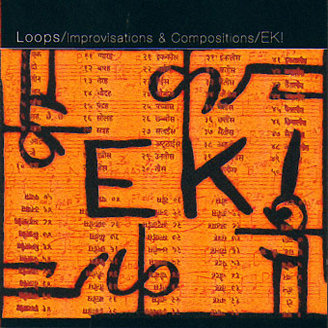
 musician
musician
“One of the most talented musicians i've ever had as a student ... highly proficient on electric bass.”Bob Moses, 1996.
ek! (Loops)

TRACKLISTING
- BAR
- Rules of the Shastra
- L.A. Rocco Jam
- Sitcom
- Ek Bisleri
- Spool
- G.S.T.
- Blues for an Abstract Youth
- Get Better
- Dance in the Trees
- The Plug
- Rhythm Changes
Album description
This double-CD is the second commercial release by the Brisbane-based band "Loops". Released in 2001, it features a change in personnel, including the replacement of drummer Ken Edie, who was a long-term musical partner of Dimond's. Since its inception in 1995, Loops has been defining and re-defining the nexus where improvisation meets composition, where jazz meets classical music, and where acoustic sound meets electronic sound.
Consisting of a core trio of Jonathan Dimond (electric bass, tabla), Jamie Clark (electric and acoustic guitar) and John Parker (drums and percussion), the band often augments itself with artists of such virtuosity and breadth as John Rodgers (violin), Soumya Chakraverty (sarod), and Gulfam Sabri (tabla). Katie Noonan (voice) guests on this recording. Loops has also performed in collaboration with projected film and early childhood theatre.
Loops has appeared in such festivals as "Pinnacles" (1996, 2001), the Brisbane International Festival of Music (1998, 2000), the Queensland Biennial Festival of Music (2001), and the Wangaratta Jazz Festival (2000). Loops was Ensemble in Residence at the Queensland Conservatorium of Music, Griffith University (2000, 2001). Loops competed as state finalists in the ABC’s innaugral "Improv Awards" (1999). New compositions were created for and premiered at most of these events.
The band has toured New South Wales, South Australia, and Victoria (2000, 2002). Other albums include "Recursion" (1999), "Journeys: People, Places" (2005) and Loops/Topology's "Airwaves: 100 Years of Radio" (2006).
Album Reviews
The members of Loops are part of a loose network of Queensland musicians who share prodigious musical gifts and a general attraction to more demanding areas of music. It might be said that they are fascinated by the elements of music. The outcome is rarely cold and clinical, however. It is more often energizing, exciting, and quite often very beautiful in a fresh, unsentimental way. While their explorations and studies have covered the broad spectrum of music, their virtuosity is perhaps most immediately apparent in the area of rhythmic complexity and precision. That Indian music has come to play a large part in their music making is not surprising. A degree of preoccupation with the elements of music, or of any particular art, is often seen as a consequence solely of modernism. In fact it is common to most forms aspiring to classicism, almost by definition, or to innovation. Perspective was very much part of an ethos in Renaissance art. Ways of thwarting the illusion of realistic depth were part of the ethos of modernism. Rules of harmony have been seen as blueprints for spiritual dogma, with certain intervals forbidden, having been given Satanic associations. One of the most exacting and deeply satisfying examples of this kind of preoccupation can be seen in the art of Mondrian, from which contrasts and parallels can be drawn with the music of Loops. Mondrian rigorously pursued two-dimensionality, so as to separate his art from nature - the better way to express what he saw as spiritual laws lying behind or within nature. The addition of any new element had to be carefully calculated, so as not to introduce depth. White planes, for instance, had to be carefully placed so that they did not recede into a 'ground' behind the colour planes. Each solution carries a charge of aesthetic and intellectual satisfaction. That Mondrian has been appropriated in more than one era by popular fashion - e.g. the dresses of Mary Quant - can be seen as both a send up of such rigour and an acknowledgement that we have learned to enjoy the results. Loops music is in direct contrast to this exclusivity, yet in close sympathy with the bracing rigour of a Mondrian. While some compositions have humorous and topical associations, a central impulse is to work out the implications and possibilities of certain rhythmic juxtapositions and displacements, certain harmonic movements and tonal associations and divergences. Bach often displayed similar concerns! Much of Loops' music has evolved from the general area known as fusion. The term ‘jazz rock’ has also been applied, but Loops have extended the rhythmic implications to the point where it becomes unavoidably clear that Indian music was as big an influence in this area as either jazz or rock. When they turn their attention to the mainstream of Indian music itself, one finds no slavish imitation but a remarkably apposite and relaxed absorption into the Loops creative field. Few listeners in this global day and age would find ‘Rules of the Shastra’ by guitarist Jamie Clark - with its effortless and accurate singing by Katie Noonan - anything but ravishingly (no pun intended) lyrical and rhythmic. The second melodic idea recalls a theme used by jazz trumpeter Don Cherry in his ‘Eternal Rhythm’ project. Jonathan Dimond's ‘LA Rocco Jam’ refers back to pre-fusion modern jazz. While there may be elements of parody, and while the form roves beyond the idiom so that it is sometimes more descriptive of modern jazz than it is the thing itself - many of the satisfactions of a modern jazz guitar trio are delivered with exhilarating felicity. The word “lyrical” has cropped up, but this should not be seen as an incongruity, an irony, or any kind of surprise. All of this music is lyrical in - as I have said - a fresh and unsentimental way.John Clare, Sydney Morning Herald. August 2001